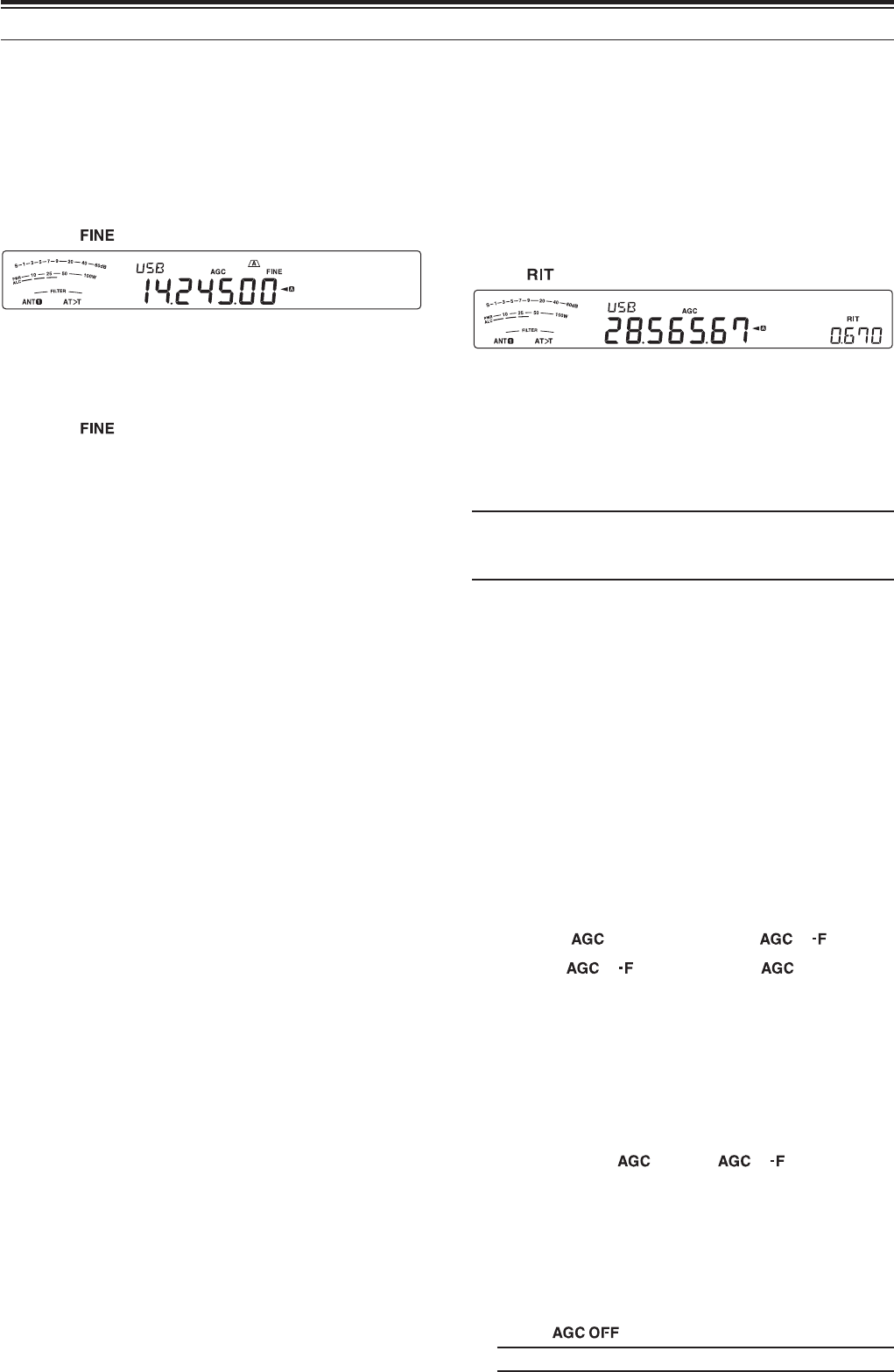
29
&20081,&$7,1*$,'6
Q )LQH7XQLQJ
The default frequency step size when turning the
Tuning control to change the frequency is 10
Hz for SSB/ CW/ FSK, and 100 Hz for AM/ FM.
However, you can change the frequency step size
to 1 Hz for SSB/ CW/ FSK, and 10 Hz for AM/ FM.
1 Press [FINE (F.LOCK)].
•“
” appears.
2 Turn the Tuning control to select the exact
frequency.
3 To quit the function, press [FINE (F.LOCK)]
again.
•“
” disappears.
Q 7XQLQJ&RQWURO$GMXVWPHQW5DWH
The default Tuning control adjustment rate is 500.
This represents the number of pulses the Tuning
control generates in a complete revolution. Each
pulse changes the tuning frequency based on the
current frequency step size (the frequency step
size for the Tuning control is 10 Hz for SSB/ CW/
FSK and 100 Hz for AM/ FM). For example, in
SSB mode the frequency step size is 10 Hz, so the
frequency would change by 5,000 Hz in a complete
revolution of the Tuning control. The adjustment
rate of the Tuning control can be lowered to 250
pulses per revolution or increased to 1000 pulses
per revolution.
1 Press [MENU], then press [Q-M.IN]/ [Q-MR] or
turn the MULTI/CH control to select Menu No.
11.
2 Press [M.IN]/ [SCAN (SG.SEL)] to select “250”,
“500”, or “1000” (default).
3 Press [MENU] to exit Menu mode.
Q (TXDOL]LQJ9)2)UHTXHQFLHV$ %
This function allows you to copy the frequency and
modulation mode of the active VFO to the inactive
VFO.
1 Select the frequency and mode on VFO A or
VFO B.
2 Press and hold [A/B (A=B)].
• The frequency and mode selected in step
1
are duplicated to the inactive VFO.
3 Press [A/B (A=B)] to confirm that the frequency
was copied to other VFO.
5,75(&(,9(,1&5(0(17$/781,1*
RIT provides the ability to change your reception
frequency by ±9.99 kHz in steps of 10 Hz without
changing your transmission frequency. If the Fine
Tuning ([FINE (F.LOCK)]) function is ON, the
frequency step size becomes 1 Hz (±9.999 kHz). RIT
works equally well with all modulation modes and
while using VFO or Memory Recall mode.
1 Press [RIT].
•
“ ” and the RIT offset appear.
2 If required, press [CL] to reset the RIT offset to 0.
3 Turn the RIT/ XIT control to change your reception
frequency.
4 To turn RIT OFF, press [RIT].
• The reception frequency is returned to the
frequency that was selected prior to step 1.
Note: When storing the frequency in a Memory channel with
the RIT function ON, the RIT offset frequency is added to or
subtracted from the VFO frequency. The calculated data is then
stored in the Memory channel.
$*&$8720$7,&*$,1&21752/
When using a mode other than FM, AGC selects the
time constant for the Automatic Gain Control circuit.
Selecting a slow time constant will cause the receiver
gain and S-meter readings to react slowly to large
input changes. A fast time constant causes the
receiver gain and the S-meter to react quickly to
changes in the input signal. A fast AGC setting is
particularly useful in the following situations:
• Tuning rapidly
• Receiving weak signals
• Receiving high-speed CW
For your convenience, the following default AGC time
constant has already been programmed.
SSB: Slow (“ ”) CW: Fast (“ ”)
FSK: Fast (“ ”) AM: Slow (“ ”)
Q $*&7LPH&RQVWDQW$GMXVWPHQW
You can pre-set up to 20 values (1 ~ 20) for the
FAST/SLOW time constant (release time).
To change the default time constant:
1 Press [AGC/T (SEL)] to select FAST or SLOW.
• The AGC time constant icon appears on the
display (“ ”: Slow, “ ”: Fast).
2 Press and hold [AGC/T (SEL)] to display the
time constant pre-set value.
3 Turn the MULTI/CH control to set your desired
time constant value.
4 If you want to turn the AGC OFF, press and
hold [CW T. (AGC OFF)].
•“
” appears on the display.
Note: You cannot adjust the time constant in FM mode.


















